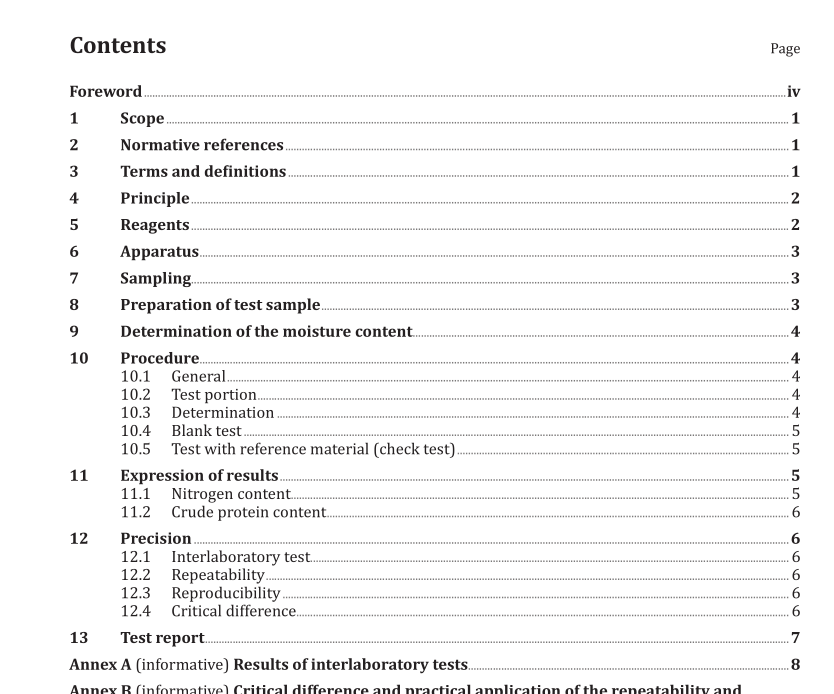ISO 20483 pdf download

ISO 20483 pdf download Cereals and pulses — Determination of the nitrogen content and calculation of the crude protein content — Kjeldahl method
1 Scope
This International Standard specifies a method for the determination of the nitrogen content of cerealspulses and derived products, according to the Kjeldahl method, and a method for calculating the crudeprotein content.
The method does not distinguish between protein nitrogen and non-protein nitrogen, lfit is importantto determine the non-protein nitrogen content, an appropriate method would be applied.NOTEIn certain cases, full recovery of the nitrogen in nitrates and nitrites is not possible by this method
2 Normative references
The following documents, in whole or in part, are normatively referenced in this document and areindispensable to its application. For dated references, only the edition cited applies. For undatedreferences, the latest edition of the referenced document (including any amendments) applies
ISO 712, Cereals and cereal products — Determination of moisture content — Reference methodISO 6540, Maize — Determination ofmoisture content (on milled grains and on whole grains)ISO 24557, Pulses – Determination ofmoisture content – Air-oven method
3 Terms and definitions
For the purposes ofthis document, the following terms and definitions apply.3.1nitrogen contentquantity of nitrogen determined after application of the procedure described
Note 1 to entry: It is expressed as a mass fraction of dry product, as a percentage
3.2
crude protein content
quantity of crude protein obtained from the nitrogen content as determined by applying the specifiedmethod, calculated by multiplying this content by an appropriate factor depending on the type ofcereal or pulse
Note 1 to entry: It is expressed as a mass fraction of dry product, as a percentage.
4 Principle
A test portion is digested by sulfuric acid in the presence of a catalyst. The reaction products are madealkaline, then distilled.The liberated ammoniais collected in a boric acid solution, which is titrated with asulfuric acid solution,in order to determine the nitrogen content and calculate the crude protein content.
Reagents
WARNING – The reagents described in 5.3,5.8,5.9 and 5.13 shall be handled with caution.
5.1 Use only nitrogen-free reagents of recognized analytical grade, except for the reference materials,and distilled or demineralized water or water of equivalent purity
5.2 Kjeldahl tablets, corresponding to the following composition: copper (ll) sulfate pentahydrate(CuSO4·5H20) = 2,8 %,titanium oxide (Ti0z)= 2,8 % and potassium sulfate (K2SO4) = 94,3 %.
Alternatively, copper(ll) sulfate pentahydrate, titanium oxide and potassium sulfate may also be mixedin the corresponding ratio.
5.3Sulfuric acid,c(H2S04) = 18 mol/l, P20(H2SO4) = 1,84 g/ml.
54Antifoaming agent: Paraffin oil, silicone or even antifoam tablets may be used to prevent foaming
5.5Acetanilide (CgHgNO) or tryptophan (C11H12N202), of minimum assay 99 % (mass fraction).
5.6Boric acid, aqueous solution, p20(H3BO3) = 40 g/l, or any other concentration recommended forthe apparatus being used.
5.7Coloured indicator
Add volumes of Solution A (5.7.1) and Solution B (5.7.2) as recommended for the apparatus being usedfor example: 5 volumes of Solution A and 1 volume of Solution B) or any other coloured indicatorrecommended for the apparatus.
NOTE1 lt is possible to use a ready-to-use solution of boric acid containing the coloured indicator(5.71 and 5.72).
NOTE 2 The ratio of Solutions A and B can be adjusted depending on the apparatus.
The titration may also be carried out potentiometrically by the use of a pH electrode, which shall bechecked every day.









